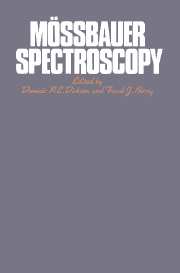Book contents
- Frontmatter
- Contents
- List of contributors
- Preface
- 1 Principles of Mössbauer spectroscopy
- 2 Mössbauer spectroscopy and the chemical bond
- 3 Mössbauer spectroscopy as a structural probe
- 4 Mössbauer spectroscopy of magnetic solids
- 5 Time-dependent effects and relaxation in Mössbauer spectroscopy
- 6 The dynamics of nuclei studied by Mössbauer spectroscopy
- References
- Index
Preface
Published online by Cambridge University Press: 15 October 2009
- Frontmatter
- Contents
- List of contributors
- Preface
- 1 Principles of Mössbauer spectroscopy
- 2 Mössbauer spectroscopy and the chemical bond
- 3 Mössbauer spectroscopy as a structural probe
- 4 Mössbauer spectroscopy of magnetic solids
- 5 Time-dependent effects and relaxation in Mössbauer spectroscopy
- 6 The dynamics of nuclei studied by Mössbauer spectroscopy
- References
- Index
Summary
Many techniques have developed in recent years which allow experimental scientists to extend their studies in new directions. An awareness of the scope, strengths, potential, and limitations of a particular technique is essential if it is to be utilised to the full. The aim of this book is to review the unique contribution that Mössbauer spectroscopy can make to the study of the bonding, structural, magnetic, time-dependent, and dynamical properties of various systems. Particular emphasis is given to the types of information which Mössbauer spectroscopy provides, as well as to a comparison with the information in these areas which can be obtained using other techniques.
In order to achieve the objectives outlined above, each of the main chapters relates to one aspect of the information which can be obtained by Mössbauer spectroscopy, and these chapters have been written by scientists with considerable experience in these different areas. We are particularly indebted to the authors of the individual chapters for embracing our overall philosophy for this book and the need to produce a coherent whole, while still reflecting their personal enthusiasm for their own particular area of interests, as well as the differences inherent in these different aspects.
One of the striking features of the growth of Mössbauer spectroscopy, following the discovery by Rudolf Mössbauer in 1957 of the effect which bears his name, was the rapidity with which the potential of the new technique was recognised and developed.
- Type
- Chapter
- Information
- Mössbauer Spectroscopy , pp. xi - xiiPublisher: Cambridge University PressPrint publication year: 1986

